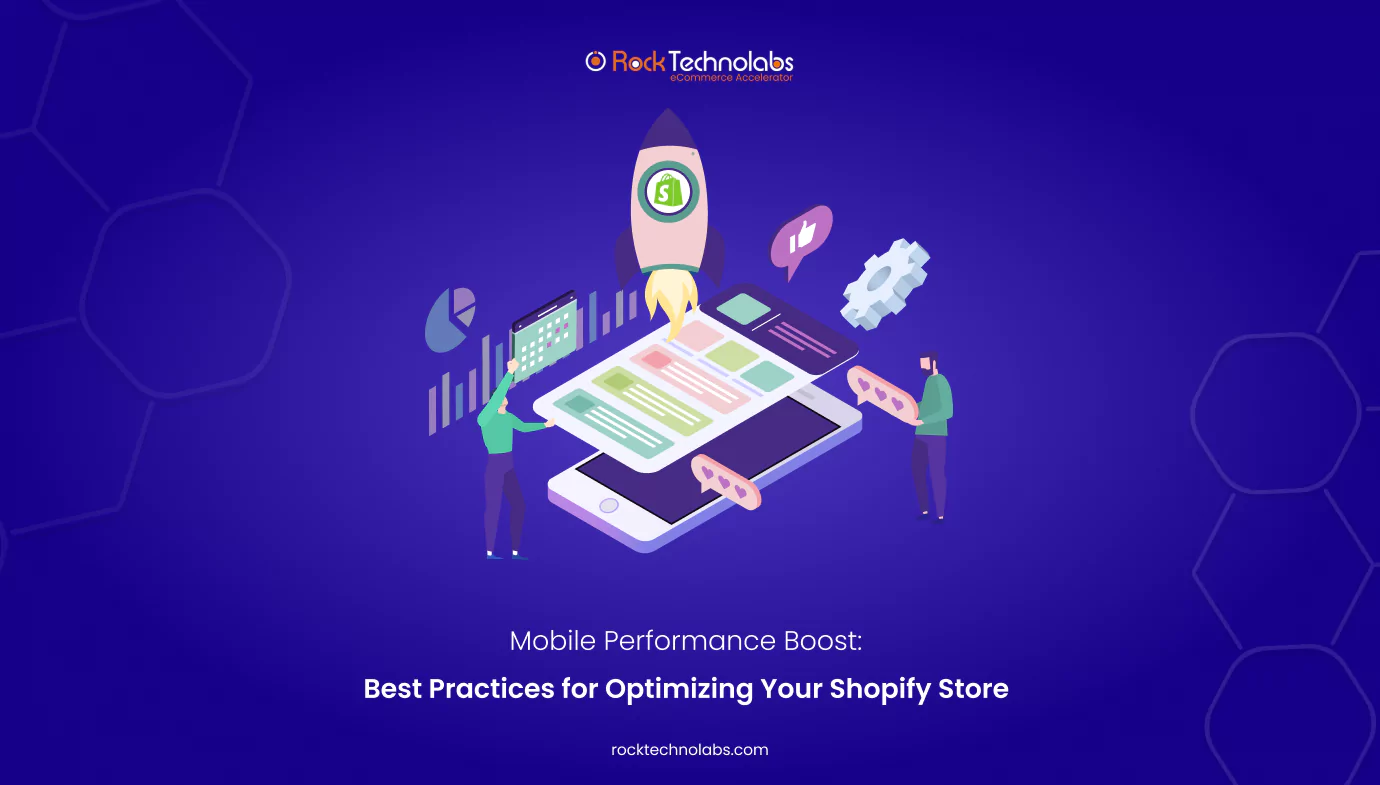Mobile Performance Boost: Best Practices for Optimizing Your Shopify Store

Nowadays, a large part of e-commerce growth is pushed by online buyers who are using their mobile devices, to purchase goods and services. Even as per the data we got from Statista’s Market Insights, mobile e-commerce sales reached $2.2 trillion in 2023, making up 60% of all e-commerce sales worldwide.
Besides this, the share of mobile e-commerce, including all e-commerce industries, has been steadily climbing, up from just 56% in 2018 to an expected 62% in 2027. This has also transitioned mobile optimization from an extra to a necessity for any e-commerce business aiming to capture and maintain the interest of today’s consumers. This has also influenced the need to opt for mobile-optimized e-commerce development and Shopify development services.
Also, now we are noticing that e-commerce owners have started optimizing their Shopify store according to mobile responsiveness but the problem is when it comes to mobile optimization or its best practices, e-commerce owners are more focused on design, which is not sufficient to generate more sales as it goes far beyond that.
To effectively convert website visitors into customers, online retailers must embrace digital transformation in all aspects of their conversion strategy while ensuring that their websites are optimised for mobile. So today, via this blog, we will help you decide the best you can do with practical advice, best practices, and often overlooked strategies to transform your Shopify store into a mobile-friendly powerhouse.
Importance of Mobile Performance for Shopify Stores
Just a simple question, would you like to wait 5-10 minutes to let a clothing online site load on your mobile, so you can explore your desired products, obviously not. You will simply abandon it, and look for any other website. This is why mobile performance for your Shopify store is crucial. By optimizing mobile site speed, you can gain a competitive advantage over businesses with slower mobile sites and cater to the growing mobile audience effectively. Users expect fast-loading websites and a slow mobile site can lead to frustration and abandonment.
In the following sections, we’ll go through different methods and tips for effective optimization of your Shopify store to boost mobile performance. Either your hired Shopify expert or any Shopify development service provider can opt for the below-given tactics to improve your store performance.
Shopify Mobile Optimization Tips To Boost Performance & Conversions
1. Content Delivery Networks (CDNs)
We recommend opting for Shopify CDN, which delivers website content to over 90 countries worldwide, enabling your customers to access your store quickly and reliably irrespective of where they are accessing your Shopify store. Shopify CDN is backed by Cloudflare and comes with a catch-hit rate of 95% that accelerates website speed, enhances performance, and improves user experience.
Moreover, it offers enhanced security by providing enhanced protocols like HTTP/3 and TLS 1.3, protecting your site and users including additional features such as protection against DDoS attacks and other cyber threats.
2. Theme Selection
The choice of theme for your Shopify store can significantly influence its mobile performance and finding the right theme for your Shopify store of if you are opting for Shopify development services is half the battle. In the Shopify theme store, you can view themes by price, industry, and feature, and even sort them by price.
Selecting a theme that is both responsive and lightweight is critical for maintaining fast load times and ensuring a smooth user experience on mobile devices for that, you can keep note of the below suggestions.
- Research and Review Themes: Explore the Shopify theme store and read customer reviews to find themes that are well-regarded for their speed and mobile optimisation. Look for themes that balance aesthetics with performance.
- Test for Responsiveness: Make sure to test the theme across various devices and screen sizes to confirm that it adjusts seamlessly. With many shoppers using smartphones, ensuring mobile compatibility is vital.
- Minimise Customizations: While customisations can enhance your store’s appearance, excessive modifications can add unnecessary code, potentially slowing down your site. Aim for a balance between personalisation and performance to maintain speed.
3. App Management
Shopify apps can greatly extend the functionality of your store but may also contribute to slower performance due to added code. Regularly reviewing and managing your apps is essential to ensure they contribute positively to your store’s efficiency.
- Audit Installed Apps: Periodically evaluate the apps you have installed to determine their relevance and impact. Identify apps that are no longer necessary or those duplicate functionalities available through other apps.
- Uninstall Unnecessary Apps: Remove apps that do not add significant value or whose functions are covered by other tools. This action reduces the amount of background code running on your site, which can help improve overall performance and speed.
4. Reduced Redirects and Broken Links
Fixing broken links, and reducing redirection of URLs is a very common task done by Shopify development service experts and is essential for maintaining a wholesome website and improving your SEO. It is also important for maintaining a smooth user experience and improving load times. Moreover, excessive redirects can slow down your site, while broken links can frustrate users:
- Audit and Optimize Redirects: Review your site’s redirects, removing unnecessary ones and using 301 redirects for permanent changes and 302 redirects for temporary ones to streamline navigation and enhance performance.
- Check for Broken Links: Remember that broken links are inevitable on your Shopify store as it scales up so you have to use online tools or Shopify apps to regularly scan for and fix broken links to ensure that all navigation is functional. You could use several tools (Google Search Console, W3C link checker, etc.) to check and fix broken links in your online store.
5. Performance Monitoring
There is no better way to optimize your marketing campaigns and operations than to track your store’s performance in real-time on a regular basis, and for this purpose, there are many tools available in the market that can easily help you with this task as it uncover critical big-picture insights around visitors, sales, checkout, key metrics, and traffic. Utilize tools to track key performance metrics:
- Set Up Google Analytics: Use Google Analytics or similar tools to monitor site traffic, conversions, and user behavior, which provides insights into how visitors interact with your store.
- Run PageSpeed Insights Regularly: Periodically analyze your site with Google PageSpeed Insights to uncover performance issues and receive actionable recommendations for improvements.
- Google Search Console: Google Search Console is a free tool that will assist you in monitoring, and maintaining the site presence in SERP. It provides key metrics for the website pages like clicks, impressions, and CTR, and helps you identify and fix indexing issues that could limit your site’s visibility.
6. Image Optimization
Image optimization simply refers to ensuring your images look flawless, and relevant on desktop and mobile and don’t hinder web performance. However, the problem with using such images that high-resolution images can dramatically slow down your store’s loading times, which can deter potential customers. To mitigate this issue, it’s essential either by you or your Shopify development service provider to compress and resize images before uploading them to your Shopify store. Using appropriate tools and techniques ensures that images retain quality while reducing file size.
- Utilize Compression Tools: Leverage tools such as TinyPNG or JPEG Optimizer, or Shopify apps like Crush. Pics, to compress images effectively. These tools reduce file sizes without compromising on image quality.
- Add Descriptive Alt Text: Include descriptive alt text for each image. This practice enhances SEO and improves accessibility for users with disabilities, ensuring a broader reach and a more inclusive user experience.
- Choose the Right File Format: Different image formats serve different purposes. Use JPEG for detailed photographs and PNG for images requiring transparency. Avoid high-resolution formats like BMP or TIFF, which are better suited for print rather than web use.
- Resize Images Appropriately: Ensure that images are resized to fit their specific role on your website. Adhering to your theme’s dimensions helps prevent unnecessary resizing during loading, which can slow down your site.
7. Streamlined Checkout Process
The default checkout process offered by your Shopify store specifically for mobile isn’t the one best optimized for your customers’ experience most of the time results in higher cart abandonment rates and lower conversion. Also, it’s very important that you aim for a checkout experience that minimises steps and makes the purchasing process as straightforward, and opts for some other below-given strategies:
- Use Google auto-address: Google Autocomplete feature reduces typing by filling in a customer’s shipping address that they have mentioned before on your site, plus it helps in reducing the errors significantly. Enable it on your Shopify store to have it automatically populate a shopper’s town, state, and ZIP code based on the first line of their address.
- Have a mobile-friendly design: It is estimated that by 2024, some 187.5 million people will shop via mobile devices, spending an estimated $621 billion so obviously, you have to focus on mobile-friendly design, for which you have to minify code, use large finger-friendly buttons, such as Add to Cart and Checkout, and keeping a responsive design that automatically resizes for different size screens.
- Offer Guest Checkout: Provide a guest checkout option so customers can complete their purchases without creating an account, which can enhance convenience and reduce friction.
8. Optimized Product Pages
Enhancing the quality and functionality of your product pages is key to providing a great shopping experience and boosting conversions:
- Use High-Quality Images: Ensure that product images are high-resolution and optimized for web use, showcasing your products effectively without compromising load times.
- Implement User-Generated Content: Add user reviews and ratings to build trust and authenticity, and incorporate related product recommendations to encourage cross-selling and upselling. Ensure all these features are designed to be fast-loading and responsive.
9. Code and Script Optimization
Optimizing your site’s code and scripts can significantly enhance load times and overall performance. For this purpose, you have to:
- Minify Your Code: Use tools like online minifies to remove unnecessary spaces, comments, and line breaks from your CSS and JavaScript files. Shopify themes also include built-in minification options to streamline code.
- Leverage Asynchronous Loading: Utilize Shopify’s script tags to load JavaScript files asynchronously. This ensures that scripts do not block the rendering of other page elements, enhancing the speed and responsiveness of your site.
Wrapping Up
We hope that this guide has given you enough tactics that you can apply to your Shopify mobile performance optimization. By implementing the best practices outlined, such as selecting responsive themes, optimizing images, and streamlining the checkout process, you can significantly enhance user experience and boost conversions.
Whether you choose to hire Certified Shopify developers or engage in Shopify development services, these strategies will transform your Shopify Store into a mobile-friendly powerhouse, ensuring you stay competitive in the growing mobile e-commerce market.







